

| Harvestmen in Nottinghamshire |
| ...... |
| Having eight legs, Harvestmen
(Opiliones) belong to the same order of Arachnida as spiders.
Similarly, because they have eight legs, they are perhaps one of the least studied
invertebrates making up the county's invertebrate fauna and for many
years, their distribution across VC56 Nottinghamshire was always difficult to ascertain.
But Dilys and myself did a great deal of work in the last decade or so and I continue that work, so at least now, the overall picture is better now than it used to be. Although less studied, harvestmen are known to everyone with even the remotest interest in natural history, being commonly found on house walls, fences and low vegetation. Quite often they find you and a good number of species can be found in suburban gardens and parks etc. |
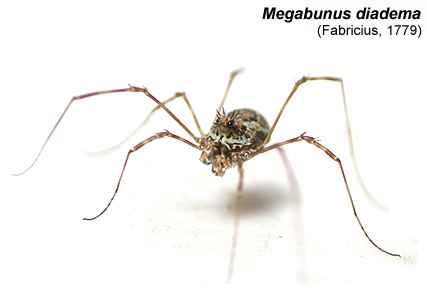 |
|
| ...... | ||
|
Known Nottinghamshire species There are currently around 30 known species of Harvestmen found in the UK, following some recent additions. Of these, some 24 species have been reliably recorded in Nottinghamshire, following the recent discovery of Dicranopalpus larvatus and Dicranopalpus caudatus. However, there are some species with a predominantly southern UK range which could yet be found here. One advantage of their study and identification, is that they are commonly found around human habitation, so it is not always necessary to have to travel any distance to find them. A Worksop house we used to visit regularly, produced several interesting species within the confines of its small terraced garden, including a new species for the UK (see Leiobunum sp. A below) and one recent colonist from the Mediterranean origin, is now common on stone walls and buildings throughout the county. |
||
| Nemastomatidae: ... Mitostoma chrysomelas and Nemastoma bimaculatum. | ||
| ...... | ||
| Phalangiidae: ... Dicranopalpus caudatus, Dicranopalpus larvatus, Dicranopalpus ramosus, Lacinius ephippiatus (not illustrated), Lophopilio palpinalis, Megabunus diadema, Mitopus morio, Odiellus spinosus, Oligolophus hanseni, Oligolophus tridens, Opilio canestrinii, Opilio parietinus, Opilio saxatilis, Paroligolophus agrestis, Paroligolophus meadii (not illustrated), Phalangium opilio, Platybunus pinetorum and Rilaena triangularis. | ||
| ...... | ||
| incertae sedis: ... Leiobunum blackwalli, Leiobunum rotundum, Leiobunum sp. A and Nelima gothica. | ||
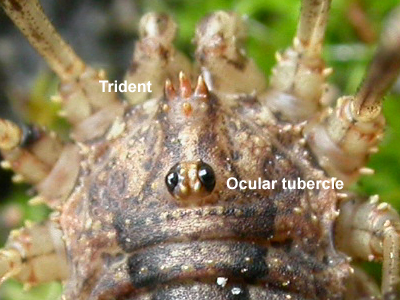 |
Harvestmen
identification Harvestmen differ structurally from spiders by having a single body, with no separate thoracic or abdominal sections. In general, the legs of all Harvestmen are longer than those of most spiders. Identification to species level becomes easier through experience, with several key features to compare and look for. One key ID aid for some species is the 'trident', which is a group of usually three or five steeply conical tubercles that look distinctly like spines. The abdomen often has rows of much smaller tubercles known as denticles, although these are missing in many species where the abdomen is smooth, or are at least very indistinct. The eyes of Harvestmen are large and raised from the rest of the body on the Ocular tubercle. |
|
| ...... | ||
| Potential
identification difficulties for the Harvestman Dicranopalpus
ramosus Length of the second pair of legs can often aid any identification, but the position of the legs at rest has always meant that the easiest species to identify in Nottinghamshire is Dicranopalpus ramosus, which rests with all eight legs held at right angles to the body in a distinctive manner. However, recent research by Hay Wijnhoven and Carlos E. Prieto, has led to some potential identification difficulties following the revalidation of Dicranopalpus caudatus (Dresco, 1948) as a seperate species and one which has been recorded from the UK and more recently from Nottinghamshire in 2025. Therefore, D. ramosus specimens should really be checked to rule out D. caudatus. |
||
| Nemastoma
bimaculatum (Fabricius, 1775) |
|||
| Found commonly under logs and within leaf litter in the Sherwood Forest area, but should be common in woodland habitats throughout much of Nottinghamshire. It's small size, coupled with the fact that they often do not move for several minutes when disturbed, means that they can be missed. Found as adults throughout the year. | |||
| ...... | |||
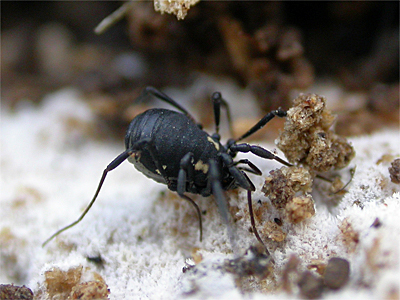 |
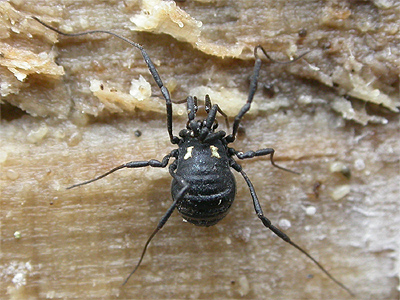 |
||
| Mitostoma chrysomelas (Hermann, 1804) |
|||
| A small, leggy Harvestman, with a body length of around 3mm. This is another inconspicuous species and at first glance, can give the impression of a juvenile Leiobunum. The adults can be found throughout the year under logs or amongst leaf litter. From our own limited number of records, this is an uncommon Harvestman in Nottinghamshire. There are three post-2000 Sherwood Forest records and an isolated record from Bunny Old Wood (per Nottinghamshire Wildlife Trust) in 1986, but the recorder is unknown. | |||
| ...... | |||
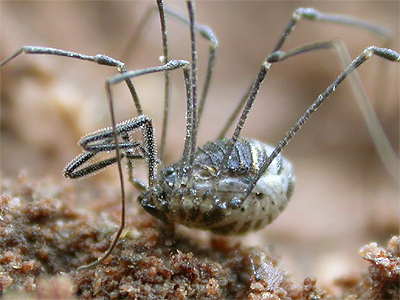 |
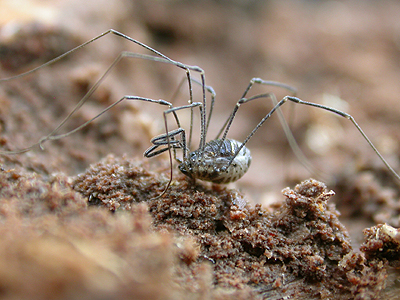 |
||
| Lacinius
ephippiatus (C.L. Koch, 1835) |
|||
| This is probably an under-recorded Harvestman in Nottinghamshire, currently known from a line of sites running from Annesley Woodhouse in the west of the county, up through the Sherwood Forest area, to Misson Carr in north. A Spring/Summer species of the ground layer, so may well be more common, if purposefully looked for through leaf litter sampling and/or seiving etc. There are recent records from Annesley Woodhouse Quarry (Williams, H. 1999), the Idle Valley Nature Reserve (Williams, H. 2000), Misson Carr (Williams, H. 2006) and Clumber Park (Brownley, N. and Brownley, S. 2025). The specimens illustrated are short of being mature and measure 3.5mm in body length. | |||
| ...... | |||
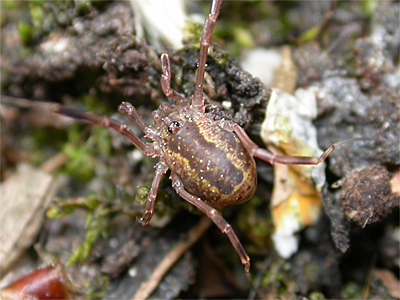 |
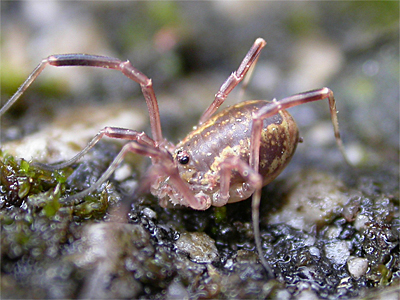 |
||
| Megabunus
diadema (Fabricius,
1779) |
|||
| Megabunus diadema is the most well marked and distinctive of all our native species, but its cryptic colouration and small size (3mm body length), mean that it is well concealed on the trunks of lichen and moss covered trees it favours. We looked in many woodlands searching for this elusive Harvestman, eventually finding it in an area of coppiced woodland. This is a fast moving species when alarmed. | |||
| ...... | |||
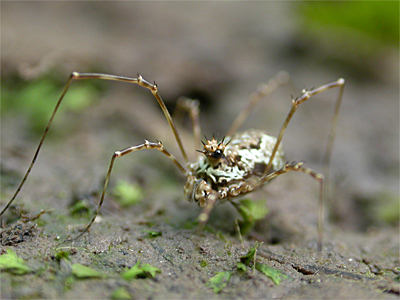 |
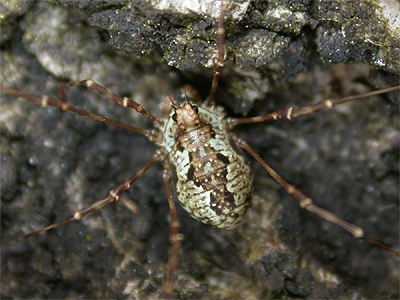 |
||
| Mitopus
morio (Fabricius,
1779) |
|||
| A very distinctively marked species, which is regularly found on low vegetation (often Nettles) at Sherwood Forest. Probably common in Nottinghamshire and found during the Summer and into the late Autumn. | |||
| ...... | |||
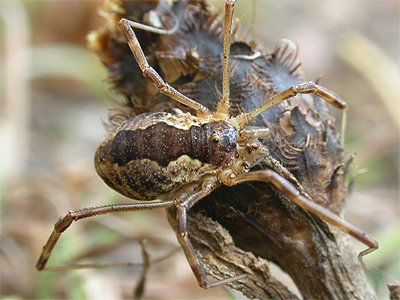 |
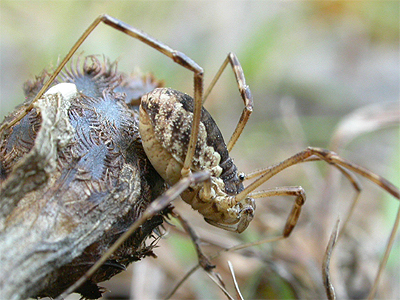 |
||
| Odiellus
spinosus (Bosc,
1792) |
|||
| The three large tubercles of the trident and the distinctive flattened appearance of the body, make Odiellus spinosus quite easy to identify. It is also a fairly large species, with females measuring 8-9mm. This is a Harvestman found around human habitation, particularly sheltered walls, where it can be found resting during the day. Typically a southern UK species, there is one record for the Sherwood NNR. Found throughout the Autumn. The one illustrated was found at Worksop in November 2009. | |||
| ...... | |||
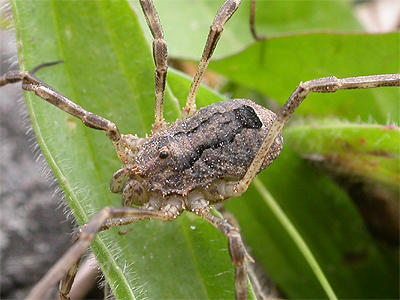 |
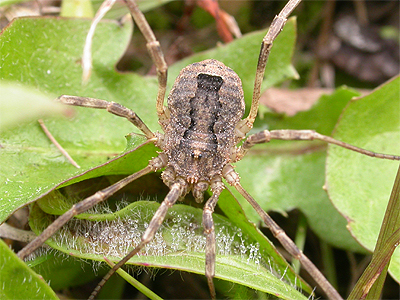 |
||
| Oligolophus
hanseni (Kraepelin,
1896) |
|||
| From our own records, this is not a common Harvestman, with just a single record in our database of this one found at New Ollerton in early November 2009. Generally difficult to distinguish by eye, from some similar species. Probably quite widespread in Nottinghamshire and very much under-recorded. | |||
| ...... | |||
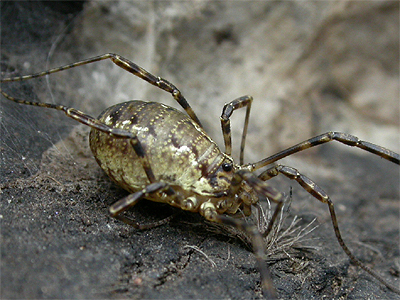 |
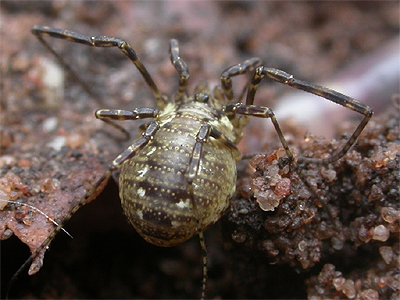 |
||
| Oligolophus
tridens (C.L.
Koch, 1836) |
|||
| A very common species of low vegetation in woodlands, found from late Summer to late Autumn. | |||
| ...... | |||
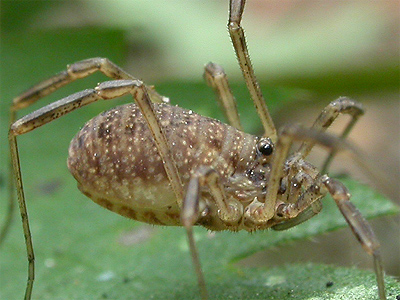 |
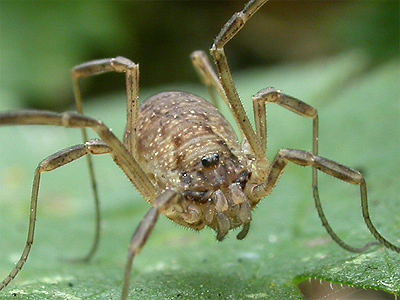 |
||
| Opilio
canestrinii (Thorell, 1876) |
|||
| This is a large and quite distinctive Harvestman. ID is relatively easy as most individuals have at least some orange colouration to the body, dark (almost black) legs with the coxa and trochanter (the two leg joints nearest the body) being orange. Opilio canestrinii is often found in gardens and around houses and is an invasive species, which seems to have replaced Opilio parietinus in most parts of the UK. These adults represent another species found at a single Worksop house. Photographed in August 2010. | |||
| ...... | |||
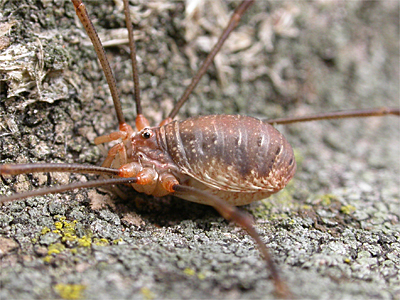 |
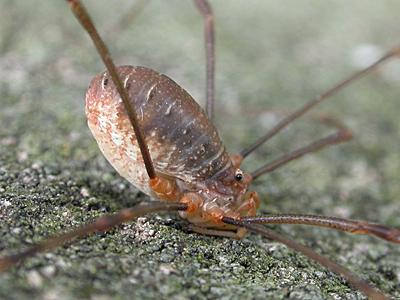 |
||
| Opilio
parietinus (De Geer, 1778) |
|||
| A large and fairly long-legged Harvestman of gardens and woods. However, it is thought to have become extremely scarce in some areas, possibly even extinct in some European countries, being replaced by the invasive European Harvestman Opilio canestrinii. However, there is currently no indication of this in Nottinghamshire and we find it commonly on the walls in the Market Warsop and Worksop areas. Adult from late Summer onwards. | |||
| ...... | |||
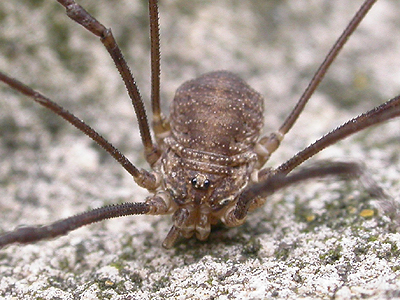 |
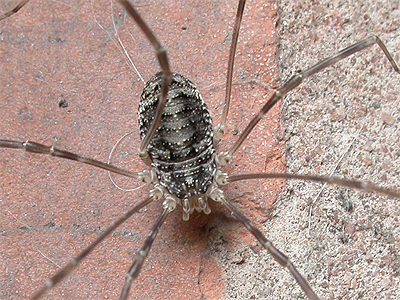 |
||
| Opilio
saxatilis (C.L. Koch, 1839) |
|||
| Probably scarce or under-recorded in Nottinghamshire. A fairly large bodied Harvestman, which was found at Market Warsop in September 2009, but has been recorded on a number of occasions. Found during the Autumn, most of our records have come from synanthropic (near buildings/urban sites) habitats. | |||
| ...... | |||
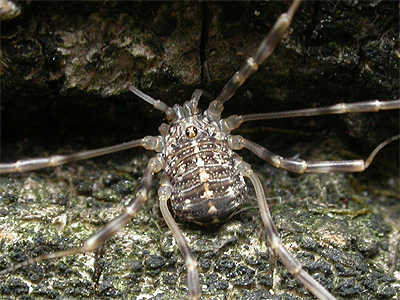 |
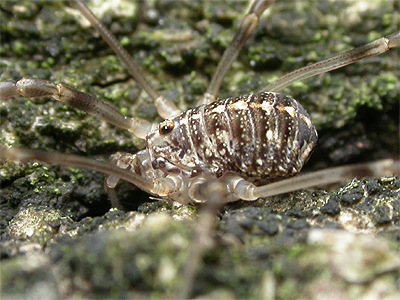 |
||
| Platybunus
pinetorum (C.L.Koch, 1839) |
|||
| Unknown in the UK until first recorded from a Sheffield garden in 2010. It has since been found at Glasgow and Aberdeen in Scotland, Northern Ireland and in the UK at Yorkshire, Northampton and a number of other towns, with an increase in records shown over the past few years and which is probably due to an increased interest in Harvestmen. Found for the first time in Nottinghamshire at Gleadthorpe near Meden Vale in May 2020. | |||
| ...... | |||
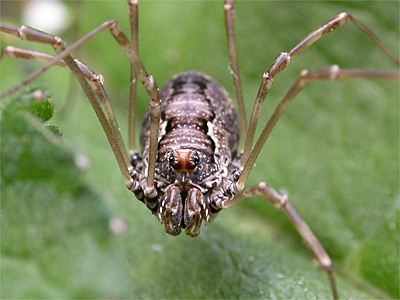 |
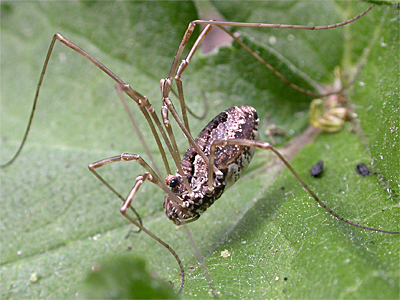 |
||
| Rilaena
triangularis (Herbst, 1799) |
|||
| One of the very few Harvestmen found as adults during the Spring. Rilaena triangularis (formerly Platybunus triangularis) is a common species of low vegetation in woods, though recorded infrequently at Sherwood Forest, which was where we found our first in late March 2010. | |||
| ...... | |||
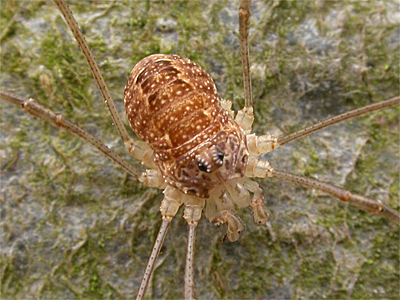 |
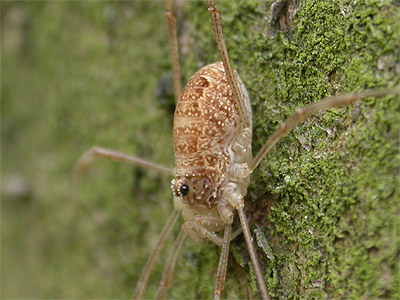 |
||
| Lophopilio
palpinalis (Herbst, 1799) |
|||
| A quite small species, which we have found under logs, but also occurs on low vegetation in woodlands. L. palpinalis is quite reddish in colouration and the ocular tubercle has two rows of large denticles, distinctive under a high magnification. Occurs during the Summer and Autumn. | |||
| ...... | |||
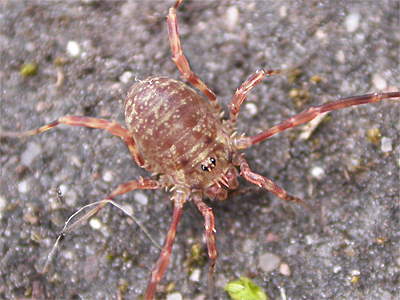 |
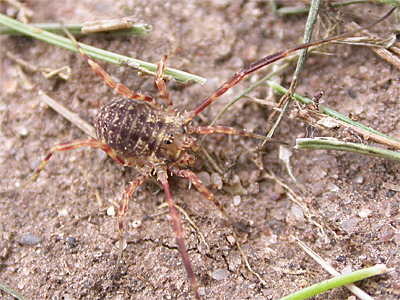 |
||
| Paroligolophus
agrestis (Meade,
1855) |
|||
| This is probably the most commonest species in Nottinghamshire. It is fairly small and short-legged in comparison to some species and is found in all habitats from Summer and well into the Autumn. Often found under loose logs, walls and on low vegetation. | |||
| ...... | |||
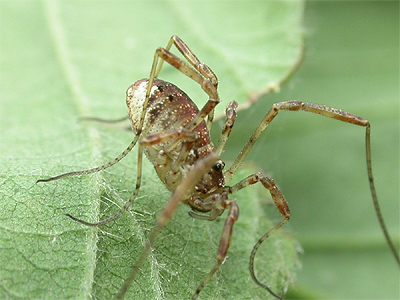 |
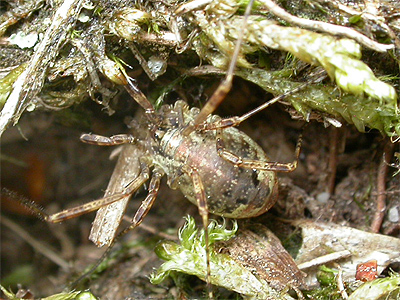 |
||
| Paroligolophus
meadii (O.P.-Cambridge,
1890) |
|||
| Rare. The only Nottinghamshire records are from Sherwood Heath SSSI (Godfrey, A.) in 2006 and from Rainworth Heath (Williams, H.) in 2010. | |||
| Phalangium
opilio (Linnaeus,
1758) |
|||
| The male is very distinctive, having two horn like projections. This is a long-legged species which we have only found on Budby South Forest (on Heather) to date. P. opilio is possibly quite restricted in it's Nottinghamshire range. Found from Summer and often well into the Winter months. Both female and male (right) are illustrated. | |||
| ...... | |||
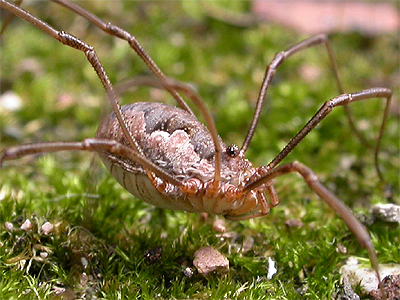 |
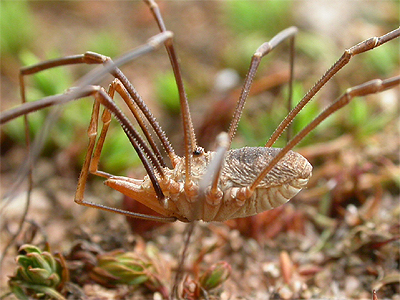 |
||
|
Dicranopalpus caudatus
(Dresco, 1948) |
|||
| Finally recorded new to Nottinghamshire in September 2025 (Pendleton, T.A.), when found on the walls of Worksop Priory, during a survey for Leiobunum sp.A in September 2025. Historically, Dicranopalpus caudatus has always been considered to be a synonym of Dicranopalpus ramosus, which is a species familiar to many. But in 2015, its status was revised and it was re-instated to species status. In the UK, there had been no records for around 30 years at the time, but it is now being found widely across much of the UK, but identification is extremely difficult and can rely on examination of the male's genitalia. However, it is thought that there are external characteristics (obviously smaller size, pale, silvery colouration), which can point a specimen towards being suspected as D. caudatus. | |||
| ...... | |||
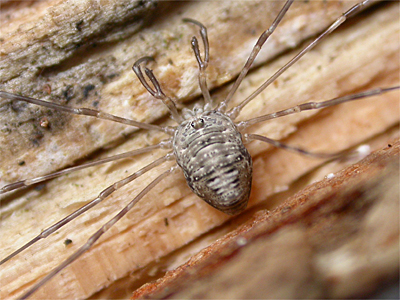 |
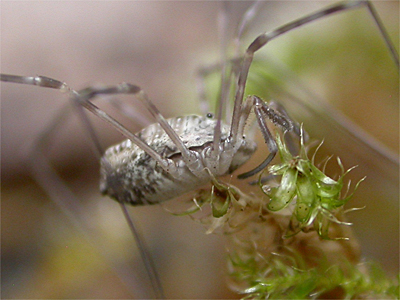 |
||
| Dicranopalpus
larvatus (Canestrini,
1874) |
|||
| Another Harvestman which is recently new to the UK, first being recorded in 2020. There soon followed occasional records of Dicranopalpus larvatus from other widely spaced parts of the country including Norfolk, Yorkshire and Caernarvonshire and although still very rare, the number of sites have since showed an increase. It is unusual compared to other species, in that it matures later in the year than other harvestmen and so should be looked for from late Autumn through to Spring. Nottinghamshire's first record, came with a female found under a small section of rotting wood, near the former kitchen garden at Woodthorpe Park in early April 2023 (Pendleton, T.A.). | |||
| ...... | |||
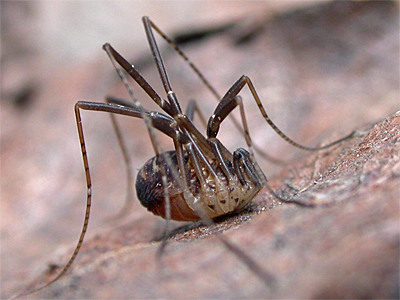 |
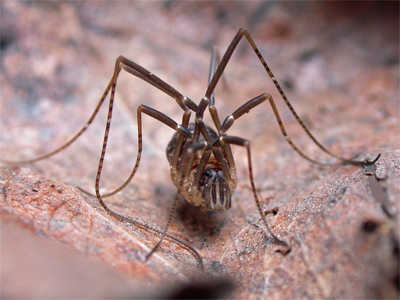 |
||
| Dicranopalpus
ramosus (Simon,
1909) |
|||
| This Harvestman first appeared in the UK in the 1950's and has now spread northwards to reach Scotland. It is widespread in Nottinghamshire, found on walls and commoly beaten from the foliage of trees and bushes. Found from late Summer to late Autumn and originally of Mediterranean origin, Dicranopalpus ramosus was once an easily identified Harvestman, but there are potentially new identification difficulties following the revalidation of Dicranopalpus caudatus (Dresco, 1948) as a seperate species. D. caudatus was formerly considered a synonym of D. ramosus and has been recorded from the UK. | |||
| ...... | |||
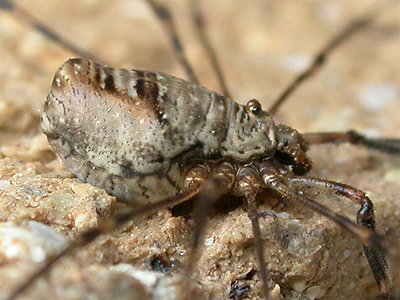 |
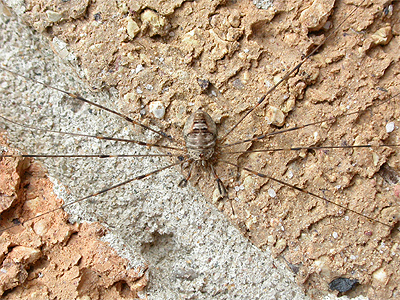 |
||
| Leiobunum
blackwalli (Meade, 1861) |
|||
| A common species of the Sherwood Forest area, often found on fence posts, low vegetation (Nettles) and tree trunks, but also found in gardens and house walls. Both sexes are very long legged and the male of this species and L. rotundum (shown below) are very similar. Found from Summer to quite late in the Autumn. | |||
| ...... | |||
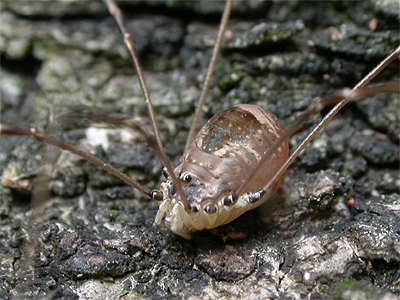 |
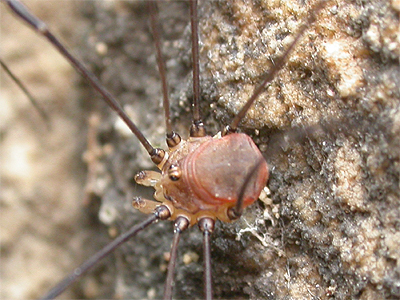 |
||
| Leiobunum
rotundum (Latreille,
1798) |
|||
| Another very long-legged species, which seems to be commoner in the Sherwood Forest area than L. blackwallii. Found in similar situations as blackwallii, but more prone to be found resting on walls and buildings. Found from Summer to quite late in the Autumn. | |||
| ...... | |||
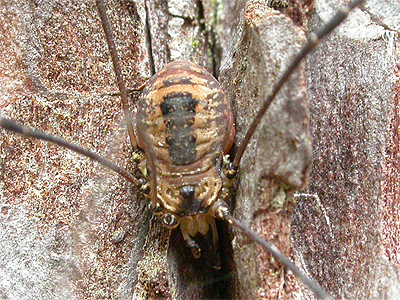 |
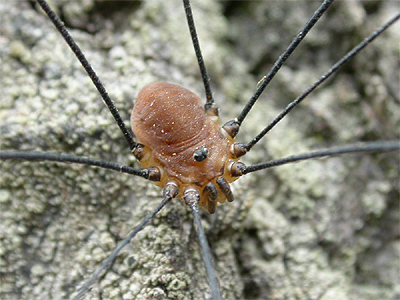 |
||
| Leiobunum
sp. A (Schönhofer &
Hillen 2008, Toss 2009, Wijnhoven et al. 2007) |
|||
| This very long-legged Leiobunum sp. A was found and photographed at Worksop in 2009, but it's ID remained a mystery until November 2011 when it was identified as the UK's first record of the potentially invasive Leiobunum sp. A. It's still scientifically impossible to fully name this Harvestman and a full account of it's discovery at Worksop, identification and European history can be found via the link below. | |||
| ...... | |||
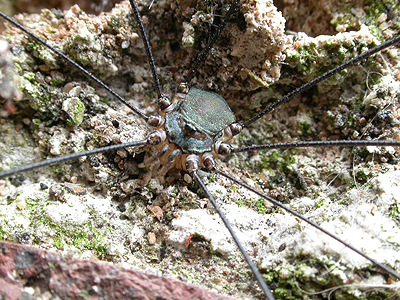 |
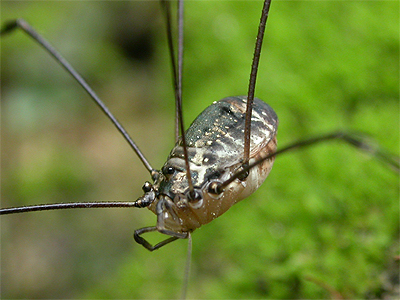 |
||
| Nelima
gothica (Lohmander, 1945) |
|||
| Rare in Nottinghamshire, with few reliable records. Very similar to a Leiobunum type Harvestman, but obviously smaller and with pale Trochanters, lighter leg colour. The specimen in the photographs is darker than is often depicted in books or on the Internet. Found from Summer, through to late Autumn, when most specimens tend to become darker. Post 2000 records come from Rainworth Heath in 2010 (Williams, H.) and Worksop Priory (Pendleton, T.A. and Pendleton, D.T.). | |||
| ...... | |||
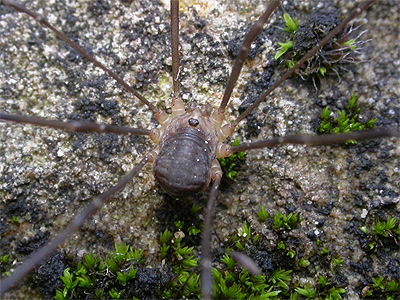 |
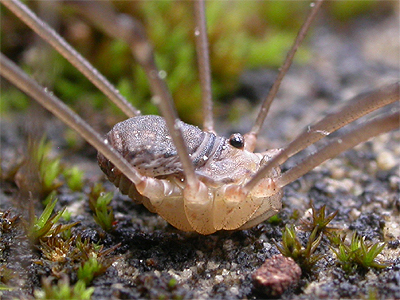 |
||